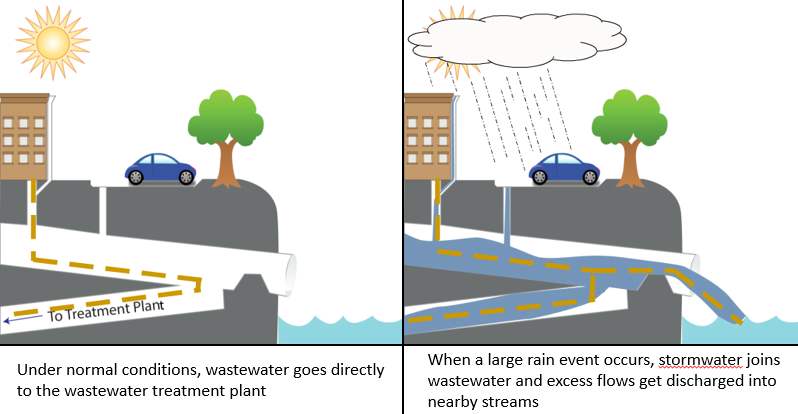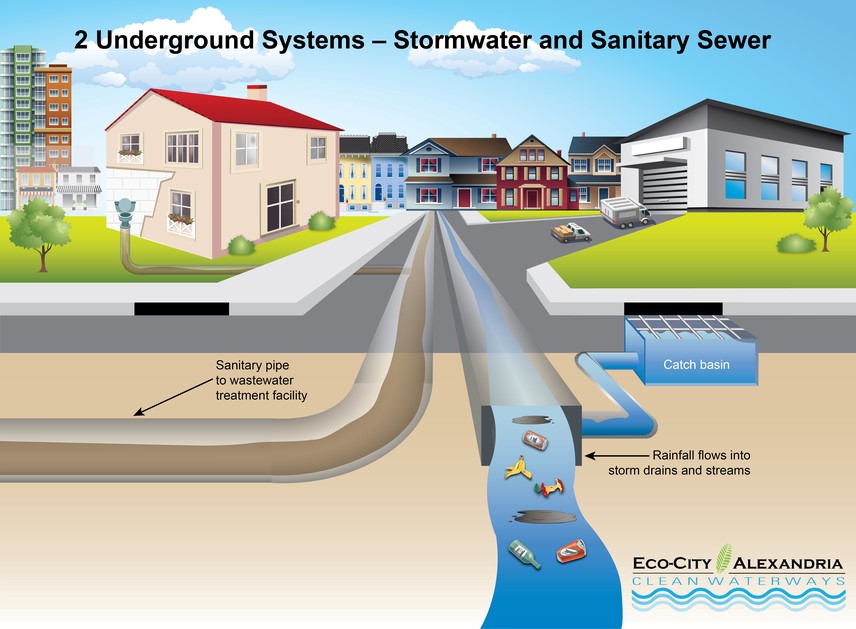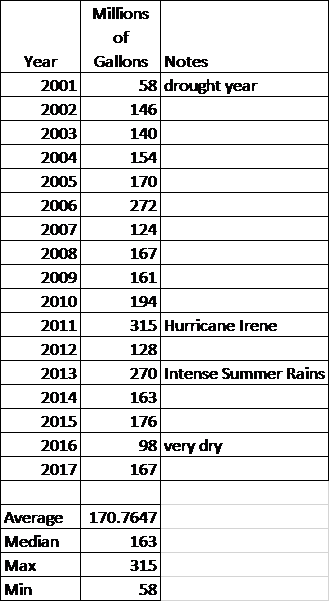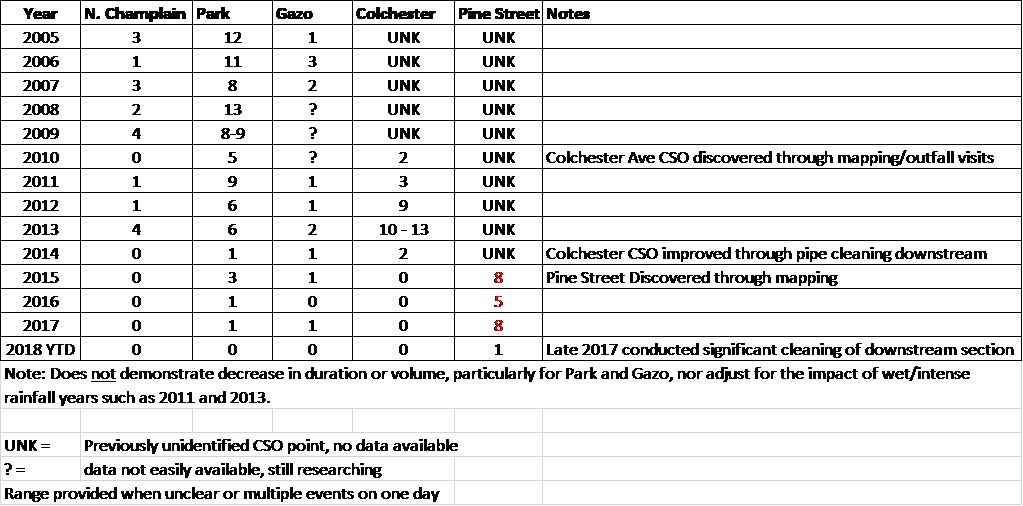Operation Clean Sweep Runs April 24 - May 2. Cars must be off-street on your night of sweeping.
Visit Clean Sweep for more details.
Operation Clean Sweep Runs April 24 - May 2. Cars must be off-street on your night of sweeping.
Visit Clean Sweep for more details.
Our Water Quality Past:
Despite the fact that sewage treatment in Burlington was discussed as early as 1905, the first large scale sewage treatment plant (Main Wastewater Treatment Plant) was not built until 1953, with North Plant and Riverside Plants built in 1961 and 1963 respectively. Main Plant was reportedly the first large scale sewage treatment plant built in Vermont. Before this time, Burlington was discharging the raw waste from its inhabitants and industries directly into Burlington Bay, Englesby Brook and the Winooski River. Until the 1920s, when gas chlorination was added to the drinking water filtration plants, waterborne illness was a common issue for Burlington’s citizens cited in the City’s Annual Reports. (See Water Resources History https://www.burlingtonvt.gov/DPW/History;)
The Wastewater Treatment Plants (WWTPs) were all upgraded for additional flow capacity and treatment improvements in the 1970s. Meanwhile, all throughout this time and even after the 1970s upgrade, the City had a number of “sewer relief points” which we now call combined sewer overflows (CSOs). As was typical of older cities, much of Burlington had only one pipe to carry both sanitary waste and stormwater flow away from the buildings and streets. Anytime the volume in the combined sewer system exceed the capacity of the wastewater treatment plant (or in some cases the local pipe network) a mixture of stormwater and untreated sewage would discharge to waterbodies around Burlington (see below). This was to protect the WWTPs and also prevent discharges from the water backing up until people’s homes, but obviously had water quality impacts. To this day, there are nearly 860 communities across the United States that still have combined sewer systems (http://bit.ly/EPAcsos).

Up until the 1990s, as Burlington grew there were on-shore sewage discharges whenever it rained to the Lake and frequent beach closures (http://bit.ly/BacT1990). Burlington voted for a $52 Million Bond to upgrade the WWTPs to improve phosphorus removal, and most importantly to greatly reduce the frequency and volume of untreated CSOs. Based on measurements of what our wet weather system treats now, it is estimated that an average of 170 million gallons of untreated, undisinfected combined sewer overflows were discharging to the Lake, the Winooski River and Englesby Brook on an annual basis until the upgrade in 1994.
Untreated CSOs eliminated as part of upgrade:
Untreated CSOs still remaining after upgrade (see “Recent Improvements” for additional information on these CSOs)
The strategy in the 1990s design for CSO abatement (either elimination or reduction of frequency) was two-fold. Sewer separation and CSO treatment. In areas where it was feasible, a separate storm sewer was installed so that the stormwater flow would not commingle with the sewage.

Table 1: Volume of Combined Sewer Wet Weather Flow Treated and Disinfected in the Vortex System
(Does not include volume treated by WWTP)

While the storm events that are conveyed to Main Plant can present additional operational challenges, this design does greatly reduce the water quality impacts presented by our combined sewer design and keeps a great deal of untreated combined sewer volume out of our waterbodies. Sewer separation is not without its water quality impacts since we now know stormwater also contains many pollutants (including bacteria from wildlife and pet waste) and discharging stormwater to water bodies over the long term can cause chronic pollution due to nutrients, sedimentation and other pollutants (see: http://bit.ly/BacT1990). Again, without the installation of the Vortex, Burlington would either still be having massive volumes of untreated combined sewer overflows or would have had to borrow millions more to fully separate. Rough estimates for complete sewer separation (putting in a new storm pipe on streets where only combined sewers exist) would likely be well over $100 million, and that would not include the installation of stormwater treatment necessary to manage long term stormwater pollution.
Burlington does continue to pursue sewer separation where it makes sense, such as when we determine that a roof drain is connected to the combined sewer system (as roof water adds volume but is not as dirty as pavement surfaces), but overall, recently we have been focusing on managing the stormwater in the combined sewer system at its source – that is, either reducing the inputs through allowing the stormwater to infiltrate into the ground (reconnecting it to its natural hydrologic cycle) or storing the stormwater and releasing it slowly to the system in a flow rate that the WWTP can fully treat in its full treatment train. Where possible, Burlington prefers implementation of green wet-weather infrastructure to maximize benefits to the community, since green infrastructure not only manages stormwater runoff, but also adds more green space, shading, pedestrian/biking, and property value improvements than typical “grey” infrastructure (storage tanks).
Managing untreated CSOs -- Recent History
As mentioned above, Burlington does still have a few remaining untreated CSOs, including two discovered as part of the City’s outfall inspection and mapping efforts in 2010 and 2015.
Map of WWTP and CSO locations (http://bit.ly/CSOloc).
Monitoring of these untreated CSOs has advanced over the years, from the early monitoring with a “fish bobber” on a string that would have to be checked after each large storm event, to the CSO alarm technology installed around 2008 (to our knowledge well before any other CSO communities) which sends out emails and text messages letting staff know that the CSO has activated and when the CSO has ended. In 2018 we have purchased and are in the process of installing permanent flow meters in these locations so that we can quantify the amount of combined sewer overflow that occurs in each event. Currently, we have to estimate the volume based on pipe size and duration of event.
Untreated CSO and Sewage Release Reporting
CSO reporting and public notification has also advanced over the years. In accordance with policies at the time, prior to approximately 2013, untreated CSO events were only reported directly to the Department of Environmental Conservation on our monthly Wastewater Discharge reports. Between 2013 and 2016, only untreated CSOs that were considered non-compliant (i.e. occurred during a storm event that did not meet the criteria of the 2.5”, 24-hour storm) were reported for publishing in the ANR public database. With the advent of the Act 86 public notification law(http://bit.ly/2t3tW30), all untreated CSOs since 2016 (regardless of the size/nature of the storm event which caused them) are reported to the ANR public notification database.
All volumes and measurements for Burlington’s treated combined sewer flows are and have been reported monthly on the Wastewater Discharge report. Per Burlington Main Plant’s permit, upsets of any portion of the disinfection system (whether the daily disinfection system or the wet weather) were required to be publically noticed within 12 hours via notification to “two radio stations and one print media” entities as well as to nearby towns, the DEC, Burlington Water and Champlain Water. More recently Act 86 added the public alert/notification system and also required the posting of beaches within 1 mile. These later requirements also apply to any situations such as a sewer back up (in the sewer system, not the WWTP) that causes a discharge of sewage to nearby waters (usually nearby separate stormwater systems where those exist)
Managing CSOs -- Continued Implementation
As shown in the tables above, while the overall volume was greatly reduced, CSOs were still occurring. Though it was recognized that Burlington had made significant gains in CSO reduction and had greatly reduced the overall volume of discharge, there were still CSOs occurring.
Table 2: Estimated Annual Frequency of CSO events since 2005

Even though some of the events listed above in Table 2 were considered compliant with the 1990 State CSO Policy (which allowed CSOs to occur if the storm event had characteristics related to the 2.5”, 24-hour storm, and did not require reporting), non-compliant CSOs were still occurring. Moreover, it was recognized that while the Vortex was treating wet-weather flow appropriately, any opportunity to remove or slow down stormwater in the combined sewer system would improve our overall Water Quality portfolio. As seen in Table 2, the efforts below have made gains in our CSO reduction journey.
How Burlington Leverages Development to Improve Water Quality
As part of the update to the Chapter 26 Ordinance, projects that disturb more than 400 sq. ft. are reviewed for stormwater impacts. The Burlington Stormwater Program is currently working to more fully codify the below principles which have been applied to commercial and industrial projects in the combined sewer system in recent years, regardless of whether or not a State Stormwater Permit is needed:
Examples of recently constructed redevelopment projects that have greatly contributed to our combined sewer runoff reduction efforts include:
Recently, as part of the on-going evolution of Burlington’s approach to combined sewer reductions, projects that are significantly increasing their sanitary wastewater flows to our plant have been required to not only manage stormwater in accordance with the framework above, but also to remove additional stormwater, either from their site (if a pure redevelopment project) or through providing funding for implementation of additional runoff reduction projects. Example include:
Future Water Quality Improvement Planning
The City of Burlington, having already invested millions of dollars into water quality improvements, is still not done. There are numerous Clean Water Act regulations (Lake Champlain Phosphorus TMDL, Updated 2016 Vermont CSO Policy, Stormwater Impaired Streams TMDL) and clean water concerns (beach closures due to E. coli from stormwater or wastewater issues, beach closures due to algae blooms) that Burlington must address.
In 2014 Burlington was awarded a Technical Assistance Grant from the EPA to begin a process called Integrated Planning, which encourages communities to examine all of their obligations in one holistic planning effort vs. as individual requirements. (See: https://www.burlingtonvt.gov/DPW/Stormwater/IMSWP)
In 2016, the City applied for a planning loan and grant from the State to begin the official Integrated Planning Process. The primary scope items of this work include:
While this work was originally anticipated to be completed at the end of 2018, early evaluations of our existing Hydraulic/ Hydrologic model revealed that additional model development and calibrations were necessary to fully optimize our water quality capital planning. Permanent flow meters were installed in early 2018 for the Main Plant collection system, and model calibration will be completed over the winter of 2018/2019.
Already, our Water Resources and Integrated Planning team has:
The remaining work and evaluations, including prioritizing the various strategies, will occur (along with more citizen engagement) over 2018-2019, with a final deliverable anticipated in early 2020. From there, Burlington will be pursuing design work and construction funding for the first round of implementation. Full implementation is likely to take upwards of 20 years, however the goal of Integrated Planning is to implement the projects with the greatest return on investment (most water quality improvement for the money) early on in the implementation cycle.
Meanwhile, while this planning effort is occurring, the Water Resources team continues to work with the rest of the City to coordinate implementation of wet weather improvements with other City investments, such as the street paving program (see Grant, King and Park street infiltration systems above). In particular, Burlington Water Resources has ensured that the upcoming Great Street and City Hall Park projects have significant improvements to stormwater/wet weather management: bio-retention areas that collect and allow stormwater to soak in and slow down before reaching the combined sewer system, permeable pavers that capture and infiltrate stormwater, and the construction of “enhanced soil volume systems” that will support the growth of healthy and robust tree canopies that can capture even more stormwater.
Other Wastewater Infrastructure Needs:
In parallel with planning Burlington’s Water Quality future, there are existing systems that need near term investment.
Currently, Burlington Water Resources anticipates a need for $8-10 Million of investment over the next 3-4 years in existing WWTP equipment to avoid future structural or mechanical issues. Additionally, approximately $1 Million of investment is needed each year for the next 5 years in our sanitary sewer/combined sewer pipe infrastructure to ensure that those pipes can continue to safely convey sewage and combined sewer flow to the WWTPs.
Burlington Water Resources will be working in FY19 to advance these projects and plan for likely borrowing through the Clean Water State Revolving Fund Loan program.